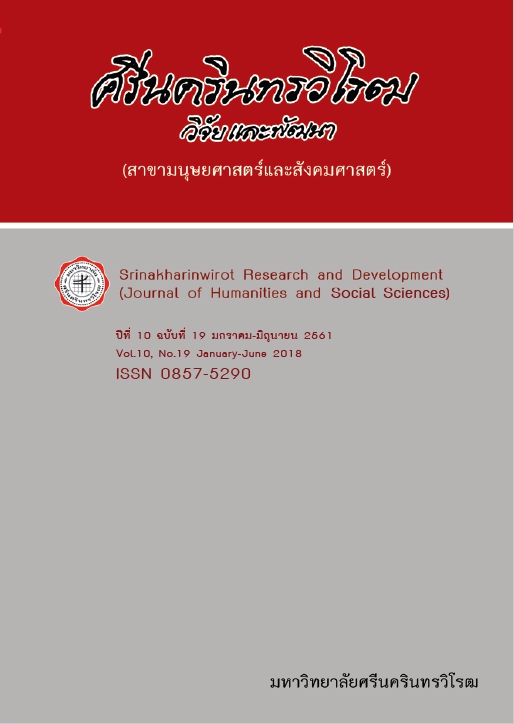การศึกษาความสัมพันธ์ระหว่างขนาดของครัวเรือนและความอยู่ดีมีสุขระดับปัจเจกบุคคล: กรณีศึกษาผู้สูงอายุในเขตกรุงเทพมหานคร (AN EXPLORATORY STUDY OF THE RELATIONSHIP BETWEEN HOUSEHOLD SIZE AND INDIVIDUALS’ SUBJECTIVE WELL-BEING IN CASE OF ELDERLY’S LIVING IN BAN
Keywords:
Household Size, Subjective Well-Being, ElderlyAbstract
This study aims to analyze the relationship between household size and individual subjective well-being in the case study of elderly in Bangkok who are 60 years old or older. Primary data were collected through questionnaires from 400 elderly persons. This study applied Generalized Order Logit and found that household size, the number of children, female, age, high income, good health and having a job were positively correlated with the subjective well-being of the elderly. The factors that have a negative relationship to the subjective well-being of the elderly were their feeling of having a lot of debt. Knowing the relationship of the factors, it can be used as an important information to prepare for the full integration into the aging society and to figure out the most suitable ways to improve elderly’s well-being. According to the results, this study suggests that the government attaches importance to the size of the household and to the child, and encourages families to have more children particularly for spouses who have just married or are not planning to have children. In addition, family members should stay home with the elderly, understand and give respect to them, and taking care them on the basis of love and gratitude.
Downloads
References
FullReport57-1.pdf
[2] ศุภเจตน์ จันทร์สาส์น. (2556, มกราคม-มิถุนายน). ความอยู่ดีมีสุขของผู้สูงอายุในครอบครัวสูงวัยในประเทศไทย. วารสารปัญญาภิวัฒน์. 4(2): 92-103.
[3] วัชรี ด่านกุล. (2557). การแลกเปลี่ยนระหว่างสมาชิกต่างรุ่นในครอบครัวต่อความอยู่ดีมีสุขของผู้สูงอายุ: กรณีศึกษาตำบลไหล่น่าน อำเภอเวียงสา จังหวัดน่าน. วิทยานิพนธ์ปริญญาศิลปศาสตรดุษฎีบัณฑิต. จุฬาลงกรณ์มหาวิทยาลัย).
[4] Yamane, T. (1967). Statistics: An Introductory Analysis. 2nd Ed. New York: Harper and Row.
[5] รศรินทร์ เกรย์; ปังปอนด์ รักอำนวยกิจ; และ ศิรินันท์ กิตติสุขสถิตย์. (2549). ความสุขบนความพอเพียง: ความมั่นคงในบั้นปลายชีวิต. นครปฐม: สำนักพิมพ์ประชากรและสังคม.
[6] นิศานาถ ถิ่นทะเล. (2550). การวัดระดับความสุขของประชาชน: กรณีศึกษาเขตพื้นที่องค์การบริหารส่วนตำบลยาวน้อย อำเภอเกาะยาว จังหวัดพังงา. รายงานการศึกษาอิสระรัฐประศาสนศาสตรมหาบัณฑิต. (การปกครองท้องถิ่น). ขอนแก่น: วิทยาลัยการปกครองท้องถิ่น มหาวิทยาลัยขอนแก่น.
[7] พิริยะ ผลพิรุฬห์; และ ปังปอนด์ รักอำนวยกิจ. (2550). ความสุขกายสบายใจของคนเมือง. นครปฐม: สำนักพิมพ์ประชากรและสังคม.
[8] พิริยะ ผลพิรุฬห์; และ ปังปอนด์ รักอำนวยกิจ. (2551). ความสุขจากทุนทางสังคม: กรณีศึกษาจากกลุ่มตัวอย่างในจังหวัดกาญจนบุรี. นครปฐม: สำนักพิมพ์ประชากรและสังคม.
[9] Layard, R. (2005). Happiness: lessons from a new science. New York: The Penguin Press.
[10] กิติยวดี สีดา; ดุษฎี อายุวัฒน์; และ มณีมัย ทองอยู่. (2551). ครอบครัววัยรุ่นชนบทอีสานในยุคโลกาภิวัตน์. ใน บทความเสนอในการประชุมวิชากรประชากรศาสตร์แห่งชาติ. กรุงเทพฯ: สมาคมนักประชากรไทย.
[11] กุศล สุนทรธาดา. (2552). รูปแบบครอบครัวกับการเกื้อหนุนและสวัสดิการผู้สูงอายุ. ใน ประชากรและสังคม 2552: ครอบครัวไทยในสถานการณ์เปลี่ยนผ่านทางสังคมและประชากร. ชาย โพธิสิตา; และ สุชาดา ทวีสิทธิ์, บรรณาธิการ. นครปฐม: สถาบันวิจัยประชากรและสังคม มหาวิทยาลัยมหิดล.
[12] Easterlin, Richard A. (2003). Explaining Happiness. Proceedings of the National Academy of Science (PNAS). 100(19): 11176-11183.
[13] Easterlin, Richard A. (2006). Life cycle happiness and its sources. Intersections of psychology, economics and demography. Journal of Economic Psychology. 27: 463–482.
[14] Helliwell, John F. (2003). How's life? Combining individual and national variables to explain subjective well-being. Economic Modelling. 20: 331-360.
[15] Helliwell, John F. (2006). Well-being, social capital and public policy: What’s new?. Economic Journal. 116: C34–C45.
[16] Helliwell, John F. & Robert D. Putnam. (2004). The social context of well-being. Philosophical Transactions of the Royal Society London. 359: 1435-1446.
[17] Margolis, R. & Myrskylä, M. (2011). A global perspective on happiness and fertility. Population and Development Review. 37(1): 29-56.
[18] Oswald, Andrew J. (2008). On the curvature of the reporting function from objective reality to subjective feelings. Economics Letters. 100(3): 369-372.
[19] Peiro, A. (2006). Happiness, satisfaction and socio-economic conditions: some international evidence. The Journal of Socio-Economics. 35: 348-365.
[20] Powdthavee, N. (2009). Think having children will make you happy. The Psychologist. 22(4): 308-310.
[21] Rojas, M. (2007). Life satisfaction and satisfaction in domains of life: is it a simple relationship?. Journal of happiness studies. 7(4): 467-497.
[22] Gujarati, Damodar N. (2004). Basic Econometric. 4th ed. NewYork: The McGraw-Hill Companies.
[23] Myrskylä, M. & Margolis, R. (2014). Happiness: before and after the kids. Demography. 51(5): 1843-1866.
[24] Schwartz, Ariel. (2015, October 2). People aren’t having babies in Denmark so they made this hilariously provocative ad. Business Insider. Retrieved March 29, 2017, from http://www.businessinsider.com/do-it-for-denmark-ad-campaign-to-encourage-pregnancy-2015-10
Downloads
Published
How to Cite
Issue
Section
License
Srinakharinwirot Research and Development Journal of Humanities and Social Sciences is licensed Under a Creative Commons Attribution-NonCommercial-NoDerivs 4.0 International (CC-BY-NC-ND 4.0) License, Unless Otherwise Stated. Please Read Journal Policies Page for More Information on Open Access, Copyright and Permissions.



